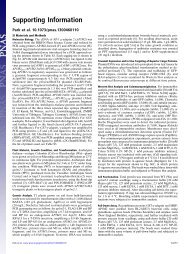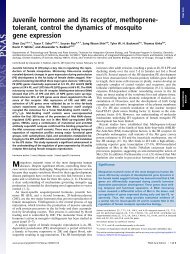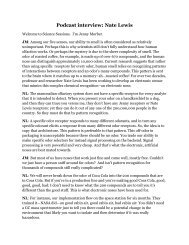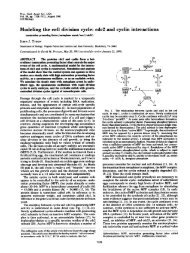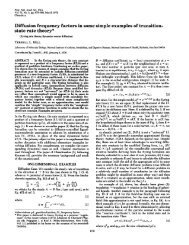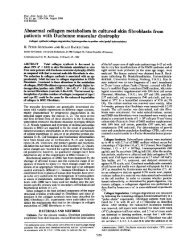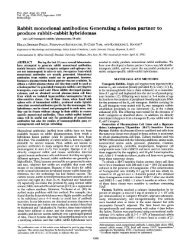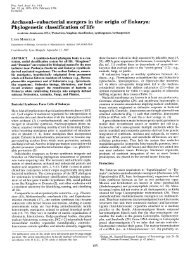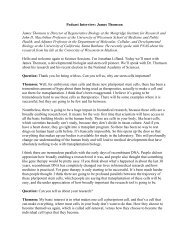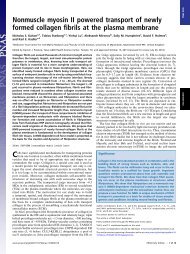Cysteine protease inhibitors as chemotherapy - Proceedings of the ...
Cysteine protease inhibitors as chemotherapy - Proceedings of the ...
Cysteine protease inhibitors as chemotherapy - Proceedings of the ...
You also want an ePaper? Increase the reach of your titles
YUMPU automatically turns print PDFs into web optimized ePapers that Google loves.
Colloquium Paper: Selzer et al. Proc. Natl. Acad. Sci. USA 96 (1999) 11021<br />
observed in inhibitor-treated T. cruzi (25). In <strong>the</strong> c<strong>as</strong>e <strong>of</strong> L.<br />
major, <strong>the</strong> site <strong>of</strong> <strong>prote<strong>as</strong>e</strong> precursor processing must be later<br />
in <strong>the</strong> trafficking pathway than that <strong>of</strong> T. cruzi, probably<br />
between <strong>the</strong> flagellar pocket and <strong>the</strong> lysosome�endosome<br />
compartment. The localization <strong>of</strong> <strong>the</strong> <strong>prote<strong>as</strong>e</strong> in secretory<br />
vesicles destined for <strong>the</strong> flagellar pocket and in <strong>the</strong> pocket itself<br />
suggests this is one pathway by which <strong>prote<strong>as</strong>e</strong> may reach <strong>the</strong><br />
lysosome. It is unclear whe<strong>the</strong>r <strong>the</strong> localization <strong>of</strong> ca<strong>the</strong>psin B<br />
to <strong>the</strong> flagellar pocket and subtending endosomal compartments<br />
represents <strong>the</strong> major route <strong>of</strong> delivery to <strong>the</strong> lysosomes,<br />
or whe<strong>the</strong>r <strong>the</strong> protein<strong>as</strong>e is also delivered directly to more<br />
mature lysosomal compartments. It is important to note that<br />
<strong>the</strong> ultr<strong>as</strong>tructural abnormalities in flagellar pocket and lysosome�endosome<br />
were seen exclusively and consistently with<br />
cysteine <strong>prote<strong>as</strong>e</strong> <strong>inhibitors</strong> regardless <strong>of</strong> <strong>the</strong>ir specific chemistry<br />
(e.g., vinyl sulfone versus dihydrazide). This observation<br />
suggests that <strong>the</strong> cellular alterations seen are due specifically<br />
to inhibition <strong>of</strong> <strong>the</strong> cysteine <strong>prote<strong>as</strong>e</strong>s <strong>of</strong> Leishmania.<br />
By labeled inhibitor studies, <strong>the</strong> predominant target <strong>of</strong> <strong>the</strong><br />
cysteine <strong>prote<strong>as</strong>e</strong> <strong>inhibitors</strong> is Leishmania cpB (Fig. 2). However,<br />
this conclusion probably reflects <strong>the</strong> fact that cpB is <strong>the</strong><br />
most abundant species in L. major prom<strong>as</strong>tigotes. In fact, <strong>the</strong><br />
<strong>inhibitors</strong> used effectively arrest <strong>the</strong> activity <strong>of</strong> both Leishmania<br />
cpB and cpL <strong>prote<strong>as</strong>e</strong>s when <strong>as</strong>sayed against <strong>prote<strong>as</strong>e</strong><br />
activity in ei<strong>the</strong>r <strong>the</strong> aqueous ph<strong>as</strong>e or detergent ph<strong>as</strong>e <strong>of</strong> a<br />
Triton X-114 ph<strong>as</strong>e separation <strong>of</strong> prom<strong>as</strong>tigote extracts<br />
(P.M.S., unpublished data). Fur<strong>the</strong>rmore, <strong>the</strong> L. major cpB,<br />
while having sequence and structure homology to o<strong>the</strong>r members<br />
<strong>of</strong> <strong>the</strong> cpB family, h<strong>as</strong> a substrate preference similar to<br />
that <strong>of</strong> cpL because <strong>of</strong> <strong>the</strong> absence <strong>of</strong> a glutamic acid side chain<br />
at <strong>the</strong> b<strong>as</strong>e <strong>of</strong> <strong>the</strong> S2 binding pocket (2). Eighty percent <strong>of</strong> <strong>the</strong><br />
total Leishmania cysteine <strong>prote<strong>as</strong>e</strong> activity me<strong>as</strong>ured by <strong>the</strong><br />
substrate Z-Phe-Arg-AMC could be inhibited by treatment <strong>of</strong><br />
prom<strong>as</strong>tigotes with 50 �M K11002 for 24 h. This w<strong>as</strong> sufficient<br />
to halt par<strong>as</strong>ite replication.<br />
A final issue concerning <strong>the</strong> Leishmania cpB and <strong>the</strong> effects<br />
<strong>of</strong> cysteine <strong>prote<strong>as</strong>e</strong> <strong>inhibitors</strong> in vivo arises from <strong>the</strong> results <strong>of</strong><br />
a study by Maekawa et al. (24), who analyzed <strong>the</strong> effects <strong>of</strong> <strong>the</strong><br />
ca<strong>the</strong>psin B-specific inhibitor CA074 on Leishmania infection<br />
in mice. Administration <strong>of</strong> this inhibitor to highly susceptible<br />
BALB�c mice resulted in a switch from <strong>the</strong> usual ineffectual<br />
TH2 cytokine response to a TH1 response that cleared <strong>the</strong><br />
Leishmania infection. These authors concluded that inhibition<br />
<strong>of</strong> mammalian ca<strong>the</strong>psin B by CA074 resulted in altered<br />
expression <strong>of</strong> Leishmania antigens on MHC cl<strong>as</strong>s II cells,<br />
producing <strong>the</strong> cytokine shift. This does not appear to be <strong>the</strong><br />
mechanism contributing to <strong>the</strong> clearance <strong>of</strong> par<strong>as</strong>ites in our<br />
study. As reported by Maekawa et al. (24), and confirmed by<br />
our own <strong>as</strong>says, CA074 alone does not inhibit Leishmania<br />
replication in vitro even at concentrations above 20 �M (our<br />
results) and 100 �M (24). Because CA074 does inhibit <strong>the</strong><br />
Leishmania cpB in direct <strong>prote<strong>as</strong>e</strong> <strong>as</strong>says, <strong>the</strong>se two results<br />
suggest that inhibition <strong>of</strong> a single type <strong>of</strong> cysteine <strong>prote<strong>as</strong>e</strong> is<br />
insufficient to block par<strong>as</strong>ite replication. It is consistent with<br />
<strong>the</strong> results <strong>of</strong> <strong>the</strong> null mutant studies on L. mexicana cysteine<br />
<strong>prote<strong>as</strong>e</strong> gene families (3, 4). On <strong>the</strong> o<strong>the</strong>r hand, administration<br />
<strong>of</strong> <strong>the</strong> vinyl sulfone inhibitor to mice in our study did not<br />
result in a switch from TH2 to TH1 cytokines, <strong>as</strong> documented<br />
by direct me<strong>as</strong>urements <strong>of</strong> IL-4 and IFN-� levels. The vinyl<br />
sulfone inhibitor is a less effective inhibitor <strong>of</strong> mammalian<br />
ca<strong>the</strong>psin B (Table 2), where<strong>as</strong> CA074 is a very specific and<br />
effective inhibitor <strong>of</strong> both <strong>the</strong> Leishmania and mammalian<br />
ca<strong>the</strong>psin B. We <strong>the</strong>refore conclude that <strong>the</strong> vinyl sulfone<br />
inhibitor exerts its effect by inhibiting par<strong>as</strong>ite replication, <strong>as</strong><br />
w<strong>as</strong> observed in in vitro <strong>as</strong>says (Fig. 1), by virtue <strong>of</strong> its ability<br />
to inhibit both cpB and cpL Leishmania <strong>prote<strong>as</strong>e</strong>s.<br />
The lack <strong>of</strong> observed toxicity to ei<strong>the</strong>r mammalian cells in<br />
culture or mice, at <strong>the</strong> concentrations or doses <strong>of</strong> cysteine<br />
<strong>prote<strong>as</strong>e</strong> <strong>inhibitors</strong> used in this study, is re<strong>as</strong>suring but in some<br />
ways surprising. Tables 1 and 2 indicate that selectivity <strong>of</strong> <strong>the</strong><br />
<strong>inhibitors</strong> versus mammalian ca<strong>the</strong>psin B, for example, is<br />
significant for <strong>the</strong> vinyl sulfone compound, but relatively less<br />
for <strong>the</strong> dihydrazides. Never<strong>the</strong>less, nei<strong>the</strong>r compound produced<br />
a significant alteration in host cells at concentrations up<br />
to 50 �M, in terms <strong>of</strong> ei<strong>the</strong>r cell replication or ultr<strong>as</strong>tructural<br />
appearance. The lack <strong>of</strong> toxicity at <strong>the</strong> doses used in mice is<br />
consistent with results <strong>of</strong> a similar study with vinyl sulfone<br />
<strong>inhibitors</strong> in <strong>the</strong> treatment <strong>of</strong> T. cruzi infection (26). We cannot<br />
rule out <strong>the</strong> possibility that inhibition <strong>of</strong> host ca<strong>the</strong>psin S by <strong>the</strong><br />
vinyl sulfone inhibitor might affect some <strong>as</strong>pect <strong>of</strong> antigen<br />
presentation. However, a range-finding toxicology study <strong>of</strong><br />
K11002 carried out at SRI International (Menlo Park, CA;<br />
Study M001–98, Project 1382–405, sponsored by <strong>the</strong> Developmental<br />
Therapeutics Branch <strong>of</strong> <strong>the</strong> National Institute <strong>of</strong><br />
Allergy and Infectious Dise<strong>as</strong>es) found no abnormalities in<br />
standard clinical chemistry tests and confirmed that toxicity<br />
(dsyspnea) in rats treated with this vinyl sulfone inhibitor w<strong>as</strong><br />
not seen until pl<strong>as</strong>ma concentrations <strong>of</strong> inhibitor exceeded 60<br />
�M in males and 120 �M in females. The <strong>the</strong>rapeutic pl<strong>as</strong>ma<br />
levels <strong>of</strong> inhibitor in <strong>the</strong> mouse study reported here (Figs. 5 and<br />
6) range between 5 and 19 �M (W. Jacobsen and L. Benet,<br />
personal communication).<br />
The selectivity <strong>of</strong> <strong>the</strong> inhibitor effects on <strong>the</strong> par<strong>as</strong>ite<br />
suggests that cysteine <strong>prote<strong>as</strong>e</strong>s are crucial to <strong>the</strong> par<strong>as</strong>ite,<br />
where<strong>as</strong> host cells are less sensitive to cysteine <strong>prote<strong>as</strong>e</strong><br />
<strong>inhibitors</strong> at <strong>the</strong> concentrations used. The lack <strong>of</strong> significant<br />
toxicity <strong>of</strong> cysteine <strong>prote<strong>as</strong>e</strong> <strong>inhibitors</strong> at <strong>the</strong> concentrations<br />
used in cell culture or achieved in mice may derive from several<br />
factors. First, par<strong>as</strong>ites appear to take up and concentrate<br />
inhibitor much more effectively than do host cell organelles<br />
(27). Host cells also have a redundancy <strong>of</strong> <strong>prote<strong>as</strong>e</strong> activity not<br />
present in par<strong>as</strong>ites. Even if one or more host cysteine <strong>prote<strong>as</strong>e</strong>s<br />
w<strong>as</strong> inhibited, <strong>the</strong>re may be little phenotypic effect.<br />
Finally, <strong>the</strong> concentration <strong>of</strong> <strong>prote<strong>as</strong>e</strong>s within host cells is<br />
substantially higher (millimolar) than that in par<strong>as</strong>ites (28).<br />
Cultures <strong>of</strong> L. major par<strong>as</strong>ites can be cured with <strong>inhibitors</strong> that<br />
target cysteine <strong>prote<strong>as</strong>e</strong>s, and, for <strong>the</strong> first time, in vivo studies<br />
suggest that dise<strong>as</strong>e progression can be reduced without<br />
toxicity to <strong>the</strong> host.<br />
We thank Christopher Franklin and Elizabeth Hansell for excellent<br />
technical <strong>as</strong>sistance, David R<strong>as</strong>nick for advice on kinetic analysis, and<br />
Dan Friend for discussion <strong>of</strong> <strong>the</strong> ultr<strong>as</strong>tructural studies. Jim Palmer<br />
(Arris Pharmaceuticals) kindly provided <strong>the</strong> vinyl sulfone <strong>inhibitors</strong>.<br />
This work w<strong>as</strong> supported by grants from <strong>the</strong> United Nations Development<br />
Programme�World Bank�World Health Organization Special<br />
Programme for Research and Training in Tropical Dise<strong>as</strong>es (T21�<br />
181�29) to J.A.S., by <strong>the</strong> National Institutes <strong>of</strong> Health (AI35707) to<br />
J.H.M., and by <strong>the</strong> National Institutes <strong>of</strong> Health (AI37977) to<br />
D.G.R. J.H.M. is supported by a Burroughs Wellcome Molecular<br />
Par<strong>as</strong>itology Scholar Award. P.M.S. w<strong>as</strong> supported by a fellowship <strong>of</strong><br />
<strong>the</strong> Deutsche Forschungsgemeinschaft (Se 762�1–1). M.B. is a University<br />
<strong>of</strong> California San Francisco Fellow.<br />
1. World Health Organization (1993) UNDP�World Bank�WHO<br />
8, Leishmani<strong>as</strong>is, Special Programme for Research and Training<br />
in Tropical Dise<strong>as</strong>e. Tropical Dise<strong>as</strong>e Research: Progress 1991–<br />
1992. Eleventh Programme Report, pp. 77–87.<br />
2. Selzer, P. M., Chen, X., Chan, V. J., Cheng, M., Kenyon, G. L.,<br />
Kuntz, I. D., Sakanari, J. A., Cohen, F. E. & McKerrow, J. H.<br />
(1997) Exp. Par<strong>as</strong>itol. 87, 212–221.<br />
3. Mottram, J. C., Brooks, D. R. & Coombs, G. H. (1998) Curr.<br />
Opin. Microbiol. 1, 455–460.<br />
4. Mottram, J. C., Souza, A. E., Hutchison, J. E., Carter, R., Frame,<br />
M. J. & Coombs, G. H. (1996) Proc. Natl. Acad. Sci. USA 93,<br />
6008–6013.<br />
5. Coombs, G. H. & Baxter, J. (1984) Ann. Trop. Med. Par<strong>as</strong>itol. 78,<br />
21–24.<br />
6. Bart, G., Frame, M. J., Carter, R., Coombs, G. H. & Mottram,<br />
J. C. (1997) Mol. Biochem. Par<strong>as</strong>itol. 88, 53–61.<br />
7. Palmer, J. T., R<strong>as</strong>nick, D., Klaus, J. L. & Bromme, D. (1995)<br />
J. Med. Chem. 38, 3193–3196.



